Today’s e-commerce customers are everywhere — browsing on smartphones, comparing prices on tablets, completing purchases on laptops, and even tracking orders via smart TVs or wearable devices.
A customer’s journey might start on a mobile app during a commute, continue on a desktop browser at work, and finish on a tablet at home.
The challenge for businesses? Consistency. Regardless of device, browser, operating system, or screen resolution, the look, feel, and performance of your store must be flawless.
Cross-platform e-commerce testing ensures that your store delivers a seamless user experience across all devices and browsers. At Testriq QA Lab, we combine real-device testing, automation frameworks, and compatibility checks to ensure your platform never loses a customer due to inconsistent design or functionality.
Why Cross-Platform Testing is Critical for E-Commerce
- Maximizes Conversions – Shoppers are more likely to complete purchases when the experience is consistent.
- Protects Brand Image – A broken layout on one device can damage trust.
- Improves Accessibility – Ensures all customers, regardless of technology, can shop easily.
- Boosts SEO – Search engines prioritize mobile-friendly, fast-loading websites.
Core Areas of Cross-Platform E-Commerce Testing
| Testing Area | Purpose | Example in E-Commerce |
| Responsive Design | Validate UI adapts to various screen sizes. | Product pages display correctly on mobile and desktop. |
| Browser Compatibility | Ensure features work across Chrome, Safari, Firefox, Edge. | Checkout process works on all browsers. |
| OS-Level Variations | Handle platform-specific behaviors. | iOS vs. Android scrolling and gestures. |
| Device-Specific Features | Validate device hardware integrations. | Camera-based barcode scanning for product search. |
| Performance Variations | Ensure equal speed across environments. | Quick load times on both high-end and low-end devices. |
Key Focus Areas for Cross-Platform E-Commerce Success
1. Mobile-First Optimization
With over 70% of global e-commerce traffic coming from mobile, testing must prioritize mobile responsiveness and speed.
We validate:
- Tap-friendly buttons and gestures.
- Optimized images for mobile bandwidth.
- Reduced load time for 3G/4G networks.
2. Browser Rendering Consistency
Different browsers interpret code differently. We ensure:
- No misaligned elements or broken layouts.
- JavaScript functionalities work consistently.
- Fonts and colors match branding guidelines.
3. Accessibility Compliance
Accessibility ensures inclusivity:
- Screen reader compatibility for visually impaired users.
- Keyboard navigation for mobility-impaired users.
- WCAG 2.1 compliance checks.
4. Real-Device Testing
While emulators are useful, real-device testing:
- Captures hardware-specific issues.
- Validates real-world performance under actual network conditions.
- Confirms gesture and touch accuracy.
Common Issues Found in Cross-Platform E-Commerce Testing
| Issue | Impact | Solution |
| Misaligned elements | Poor UX, user frustration. | Responsive CSS fixes, flexible grid layouts. |
| Feature incompatibility | Certain actions fail on specific browsers. | Polyfills, browser-specific adjustments. |
| Slow load times on low-end devices | Higher bounce rates. | Image compression, code optimization. |
| Payment gateway errors | Failed transactions on certain browsers. | API compatibility testing. |
Best Practices for Cross-Platform E-Commerce QA
- Test Early & Often – Detect compatibility issues before release.
- Automate Repetitive Scenarios – Use tools like Selenium, Cypress, and BrowserStack for regression checks.
- Leverage Cloud Device Labs – Access hundreds of device/browser combinations.
- Prioritize Based on Traffic Data – Test on the devices and browsers your customers use most.
Advanced Testing Strategies
1. Geo-Device Testing
Test how your platform performs for customers in different countries, factoring in network latency and localization.
2. Cross-Platform Payment Validation
Ensure every payment method works across devices:
- Credit/Debit Cards.
- Mobile Wallets (Apple Pay, Google Pay).
- UPI and local payment gateways.
3. Visual Regression Testing
Automated comparison of UI screenshots to detect unwanted layout changes.
FAQs: Cross-Platform E-Commerce Testing
Q1: How often should cross-platform testing be done?
Ideally, before every major update or seasonal campaign. For ongoing operations, quarterly compatibility checks keep your store consistent across devices.
Q2: Do I need real-device testing if I use emulators?
Yes — emulators can’t perfectly replicate real-world performance, battery usage, or hardware-specific issues.
Q3: Can cross-platform testing improve conversions?
Absolutely. A consistent, frictionless experience reduces abandonment rates and increases trust, leading to higher sales.
Q4: Which devices should be prioritized for testing?
Focus on the top 10–15 devices and browsers your customers use, based on analytics data.
Final Thoughts
In today’s multi-device world, your e-commerce store is judged not just on what it sells but how it sells it. A stunning desktop experience means nothing if the mobile version is clunky or broken.
Cross-platform e-commerce testing isn’t an optional QA step — it’s a strategic necessity. It protects your brand reputation, maximizes conversions, and keeps customers loyal regardless of where they shop.At Testriq QA Lab, we go beyond basic compatibility checks. We replicate real customer journeys, test on actual devices, and deliver actionable fixes that ensure your store works flawlessly everywhere.
About Jayesh Mistry
Expert in E-commerce testing service with years of experience in software testing and quality assurance.
Found this article helpful?
Share it with your team!
